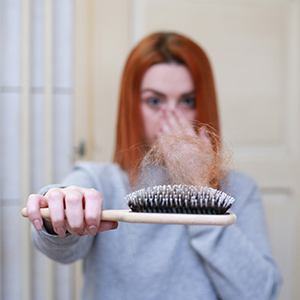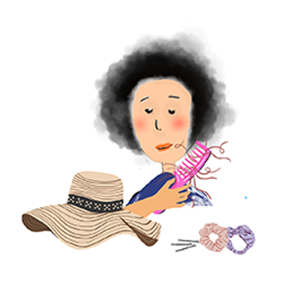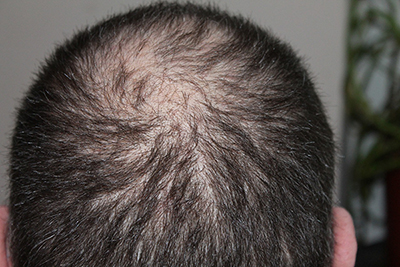Causes of hair loss are varied and complex. As it impacts both men and women, slow but steady hair loss can be traumatic. This process is clinically recognized as a risk factor for depression, anxiety, and even suicide.1
Microneedling (MN), with the addition of Low-Level LED Light Therapy (LLLT), offers a valuable treatment option, which is safe, successful, minimally invasive, and is generally at a lower price point compared to conventional options. Simultaneous use of both MN and LLLT has been shown to improve hair density.
“As an adjunct therapy, MN improved hair parameters across genders
and a range of hair loss types, severities, needling devices.” 3
In 2021 a peer reviewed article, “Microneedling and Its Use for Hair Loss Disorders: A Systematic Review,” was published in Dermatology and Therapy. It reviewed 22 clinical studies with a total of 1,127 human test subjects. The above quote is taken from that article.
It concludes that Microneedling (MN) is in fact a viable treatment for hair loss irrespective of gender, type of hair loss, or severity of hair loss. This publication additionally cites that no adverse events were reported with MN therapy. Considering the large number of studies and participants, the findings of only favorable benefits are exceptionally impressive.
Microneedling has been clinically proven to:
- Assist regeneration and regrowth of hair follicles,
- Improve dermis level step cell growth4
Clinical Studies in Hair Loss Confirm These Results Following Microneedling Treatments:
Increases in Platelet Derived Growth Factor (PDGF)
Why is it good that PDGF is boosted after Microneedling treatments? Platelet Derived Growth Factor sparks inactive hair follicles to enter into the active growth cycle and start the process of new hair growth.5,6
Increases in Epidermal Growth Factor (EGF)
Why is it good that EGF is boosted following Microneedling treatment? EGF is a key amino acid in your skin. Microneedling raises EGF. Higher amounts of EGF stimulate your hair follicle cells in two ways. First: the numbers of your hair follicle cells increase. Second: the hair follicle cells also become more active.7
Increases in Hair Bulge Activity
What is Hair Bulge Activity and how important is it as it relates to your hair loss? The bulge area of your hair follicles is filled with powerful stem cells. However, those cells can be dormant, in sleepy phases. To make new hair, those cells must awaken—be active—and also be specifically primed by nutrients circulating in your blood. After Microneedling, the perfect cellular environment has been created for your hair bulge stem cells to flourish. This promotes your hair follicle cells to launch into hair growth instead of maintaining a resting phase.8
Basics About Hair Growth & Hair Loss
 It is important to understand that not every hair on anyone’s head grows continuously. Instead, hair follicles naturally alternate between growth and rest periods. A single hair may last 2-4 years. Approximately 80-95% of the hair on our heads is in active growth phase (aka Anagen phase). The rest are in Telogen or resting phase before they fall out and are replaced by new growth. This is the normal process. A hair loss of about 100 hairs per day is considered to be normal turn over in the hair growth process.
It is important to understand that not every hair on anyone’s head grows continuously. Instead, hair follicles naturally alternate between growth and rest periods. A single hair may last 2-4 years. Approximately 80-95% of the hair on our heads is in active growth phase (aka Anagen phase). The rest are in Telogen or resting phase before they fall out and are replaced by new growth. This is the normal process. A hair loss of about 100 hairs per day is considered to be normal turn over in the hair growth process.
Hair has 3 Natural Stages of Growth:
Growing phase (Anagen)
Regression phase (Catagen)
Resting phase (Telogen)
In some types of hair loss, it has been found that the follicles stay in the sluggish or inactive Catagen or Telogen phases for longer periods. In other types of hair loss, the hair follicles progressively shrink in size. There can also be issues of scarring of the scalp, nutritional deficiencies, or chemical damage which contribute to thinning hair.
Below, I will briefly review the basic science regarding types of hair loss. However, simply understanding these definitions is not the recommended way to determine what kind of hair loss you have. It is key to understand the source of your hair loss in order to select the best therapies, products, and lifestyle changes to achieve the best results in your hair regrowth.
Ideally, if you suffer from hair loss, I recommend that, you get an evaluation by a Certified Trichologist. Trichology is the scientific study of the hair and scalp with respect to disorders and diseases specifically affecting the hair and scalp. It is crucial to understand what exactly is causing your hair loss. A Certified Trichologist has unique tools that include specialized microscopes, polarized light microscopy, and professional hair and scalp analysis methods to discern what is happening and how best to treat it.
Once you discover the exact type of hair loss you have, you can then learn about the best ways to effectively address it. Science recognizes that the stem cells located in your hair follicles maintain the capacity to wake up, receive new marching instructions, and become active once again in the production of new hair. This is the case for all types of hair loss. This is where Microneedling assists in that magnificent process of hair regrowth.
Types of Hair Loss
Hair Loss (HL) is a complicated occurrence. There are 3 types:
Androgenetic Alopecia (AGA) is caused by genetics and hormones. It is considered the most common factor in Male Pattern HL and Female Pattern HL.
Alopecia Areata (AA) is caused by an autoimmune response in the body.
Telogen Effluvium (TE) is caused by an illness or extreme physical or psychological shock.
Androgenetic Alopecia (AGA)
 AGA affects both men and women, with usual onset occurring after puberty. There are profound impacts to quality of life associated with AGA such as anxiety and depression. In this type of hair loss, the hair follicles shrink. This is known as “progressive miniaturization” of the hair follicles. At this time Minoxidil and Finesteride are the only FDA approved topical medications that can be used to treat AGA. 9
AGA affects both men and women, with usual onset occurring after puberty. There are profound impacts to quality of life associated with AGA such as anxiety and depression. In this type of hair loss, the hair follicles shrink. This is known as “progressive miniaturization” of the hair follicles. At this time Minoxidil and Finesteride are the only FDA approved topical medications that can be used to treat AGA. 9
Female Androgenetic Alopecia (FAGA) is a type of hair loss wherein the pattern is loss of hair in the center or crown of the head but the hair line at the forehead remains intact. FAGA is not associated with scarring on the scalp as are some of the other diagnoses. “Andro” applies to hormone dysregulation and “genetic” means there is also a hereditary factor that’s involved. The other finding with FAGA is progressive miniaturization of hair follicles as well as more hair follicles are in the Telogen phase of the hair growth, thus not actively growing hair.10
Alopecia Areata (AA)
 Alopecia Areata (AA) is a hair loss diagnosis stemming from an autoimmune condition. Autoimmune conditions cause the body to essentially attack itself, which usually causes tissue destruction of some sort. The exact mechanisms of AA are not fully known at this time. However, it is known that the immune system manufactures proteins which attack the hair follicle cells or make it difficult for the stem cells of the hair to maintain health and remain active. For people with active AA, 70-90% of their hair follicles will remain in the Catagen (Regression hair growth phase) or Telogen (Resting hair growth phase).11
Alopecia Areata (AA) is a hair loss diagnosis stemming from an autoimmune condition. Autoimmune conditions cause the body to essentially attack itself, which usually causes tissue destruction of some sort. The exact mechanisms of AA are not fully known at this time. However, it is known that the immune system manufactures proteins which attack the hair follicle cells or make it difficult for the stem cells of the hair to maintain health and remain active. For people with active AA, 70-90% of their hair follicles will remain in the Catagen (Regression hair growth phase) or Telogen (Resting hair growth phase).11
Alopecia Areata initially presents with oval-shaped areas of hair loss which come and go. About 25% of people with AA say that family members have also suffered with these same patterns of hair loss. This suggests that there is a genetic or inherited predisposition.
General Statistics for Alopeical Areata (AA)
-Women are at slightly higher risk of developing it.
-34-50% have mild AA, i.e., fewer symptoms will have a spontaneous resolution.
-14-25% will have eventual complete loss of scalp hair.
-AA is not considered dangerous but does carry significant risk for psychological and quality of life complaints.12
At this time conventional medicine tends to treat AA with topical or oral steroids. Random clinical trial results vary, but some do show positive results. One risk with topical steroids is folliculitis (infections occurring inside the hair follicles). That is a side effect which can further stress the hair growth cycles.
Sometimes corticosteroids are given as injections into the scalp areas of hair loss. These can be both painful and also must be limited due to the side effect of skin atrophy at steroid injections sights. Atrophy means that the dermis, epidermis, subcutaneous fat and muscle all become markedly thin.13 The various layers of skin and musculoskeletal tissues all contain precious growth factors, so it is important to protect and preserve them.
Telogen Effluvium (TE)
As noted above there are 3 natural growth cycles of your hair: Anagen (Growth), Catagen (Regress), and Telogen (Rest). Anagen phase hairs are actively growing and they typically account for the majority 85-90% of your hair. At any given time about 14% of your hair is normally in the Telogen phase and 1% of your hair is in the Catagen phase.
Your Anagen phase hairs remain in this phase for perhaps 2-4 years and then go into the Telogen Phase (Resting phase) for 2-4 months. After this time frame, the hair falls out and is replaced by new growth. These phases and cycles account for most people losing about 100 hairs per day. This is considered normal hair loss.
When a person has Telogen Effluvium (TE), this indicates a shock or physical stressor which pushes up to 30% of the hair into the Telogen Phase earlier than usual. TE occurs when substantially more hair goes into a resting or non-growth phase. When this happens, much more hair falls out and is not being replaced by new growth. Therefore, someone with TE can lose up to 300 hairs per day or more because their hairs are cannot live as long and thus fall out more quickly.
Since the 2020 COVID-19 pandemic, 2020, Hair Loss (HL) has been documented in both men and women following severe acute respiratory syndrome of Coronavirus-2 (SARS-CoV-2). As soon as 2021, medical journals began publishing findings of hair loss in patients that suffered Covid infections.14 It is well-known that a severe infection or physical shock can directly cause Telogen Effluvium (TE).
From a purely physiological point of view this makes sense. When the body is conserving energy for survival, the circulation to superficial skin surfaces will be reduced so as to shunt oxygen and nutrients to the inner organs. TE occurs when substantially more hair goes into a resting or non-growth phase. When this happens, much more hair falls out and is not being replaced by new growth.
Medical studies in Spain and India found that hospitalized Covid-19 patients developed:
- Higher rates of Pattern Hair Loss (PHL) than age-matched non-Covid-19 patients
- More severe Pattern Hair Loss (PHL) than age-matched non-Covid-19 patients1
Microneedling for all types of Hair Loss ~ How It Works:
- Stimulates collagen production
- Increases growth factors
- Promotes new formation of blood vessels
How Does A Microneedling Treatment for Hair Loss Work?
I use what’s called an electronic pen, with an oscillating sterile tip of 12 mini-needles. These tiny needles gently make shallow (0.75mm for scalp) micro-penetrations to the topmost layer of your scalp. Scientific research has repeatedly shown that these micro conduits do NOT damage your skin or cause scarring. Multiple studies indicate that these “micro-injuries” stimulate your body’s fibroblast cells in the dermis to ramp up the process of creating collagen and elastin.
As research consistently reflects: Microneedling is a safe, effective, minimally invasive and an economical treatment option for male and female hair loss. For more information on topicals, recommended assessments and new discoveries, please see my blog at: KReynoldsAcupuncture.com.



